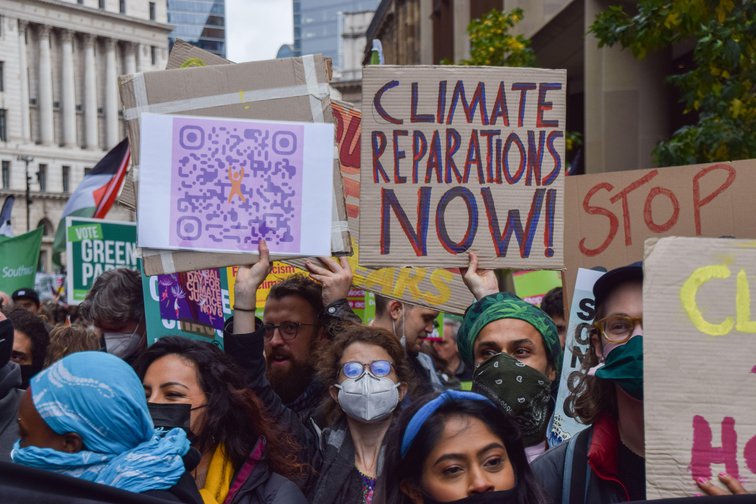August 14, 2023 Reading Time: 2 minutes

Reading Time: 2 min read
Timothy Shankar
Research Intern, Lakshman Kadirgamar Institute of International Relations and Strategic Studies.
Michael Iveson
Research Fellow (Global Economy), Lakshman Kadirgamar Institute of International Relations and Strategic Studies.
Abstract:Climate change disproportionately affects developing countries, with 15% of South Asia’s GDP expected to be climate-compromised by 2050. Despite developed countries having historically contributed to three-fourths of carbon dioxide emissions, they are much less exposed to the consequences of climate change. Economic development driven by emissions-led growth now insulates developed countries from the consequences of climate change, leaving lower-income countries more vulnerable to the adverse effects the climate crisis poses. As the global economy contends with severe debt distress and increased climate risk that threatens long-term economic potential, the global financial system must empower developing countries to invest in climate-resilient infrastructure and prevent a ‘climate debt trap.’ This Policy Brief examines why accessible climate finance is essential to address converging debt and climate vulnerabilities in Sri Lanka, and identifies mechanisms to unlock concessional finance that will allow Sri Lanka and other developing countries to reallocate funds into climate-resilient infrastructure investments and climate change adaptation and mitigation measures.
දේශගුණික විපර්යාස සංවර්ධනය වෙමින් පවතින රටවලට අසමාන ලෙස බලපාන අතර, 2050 වන විට දකුණු ආසියාවේ දළ දේශීය නිෂ්පාදිතයෙන් 15% ක් දේශගුණික බලපෑම්වලට ලක් වනු ඇතැයි අපේක්ෂා කෙරේ. සංවර්ධිත රටවල් ඓතිහාසිකව කාබන් ඩයොක්සයිඩ් විමෝචනයෙන් හතරෙන් තුනකට දායක වී ඇතත්, ඒවා දේශගුණික විපර්යාසවල බලපෑමට නිරාවරණය වන්නේ ඉතා අඩුවෙනි. විමෝචනය මූලික කරගත් වර්ධනය මගින් මෙහෙයවනු ලබන ආර්ථික සංවර්ධනය, සංවර්ධිත රටවල් දේශගුණික විපර්යාසවල ප්රතිවිපාකවලින් පරිවරණය කර ඇති අතර, අඩු ආදායම්ලාභී රටවල් දේශගුණ අර්බුදය විසින් ඇති කරන අහිතකර බලපෑම්වල වැඩි අවදානමට ලක් වේ. ගෝලීය ආර්ථිකය දැඩි ණය පීඩාවකින් සහ දිගුකාලීන ආර්ථික විභවයන්ට තර්ජනයක් වන දේශගුණික අවදානම් සමඟ පොරබදමින් සිටින බැවින්, ගෝලීය මූල්ය පද්ධතිය විසින් සංවර්ධනය වෙමින් පවතින රටවල දේශගුණයට ඔරොත්තු දෙන යටිතල පහසුකම් සඳහා ආයෝජනය කිරීම සහ ‘දේශගුණික ණය උගුල්’ වැලැක්වීමට කටයුතු කල යුතුය. ශ්රී ලංකාවේ අභිසාරී ණය පිලිබඳ ව සහ දේශගුණික අවධානම සඳහා ප්රවේශ විය හැකි දේශගුණික මූල්ය අරමුදල් අත්යවශ්ය වන්නේ මන්දැයි මෙම ප්රතිපත්ති අධ්යනයෙන් විමසා බලන අතර, ශ්රී ලංකාවට සහ අනෙකුත් සංවර්ධනය වෙමින් පවතින රටවල දේශගුණයට ඔරොත්තු දෙන යටිතල පහසුකම්, ආයෝජන සහ දේශගුණික විපර්යාස සඳහා අරමුදල් නැවත වෙන් කිරීමට ඉඩ සලසන සහනදායී මූල්ය විවෘත කිරීමේ යාන්ත්රණයන් හඳුනා ගනී.
காலநிலை மாற்றம் வளரும் நாடுகளை விகிதாசாரமாக பாதிக்கிறது, தெற்கில் 15% உள்ளது ஆசியாவின் மொத்த உள்நாட்டு உற்பத்தியானது 2050-க்குள் காலநிலை சமரசமாக இருக்கும் என்று எதிர்பார்க்கப்படுகிறது. வளர்ந்த நாடுகள் இருந்தாலும் வரலாற்று ரீதியாக நான்கில் மூன்று பங்கு கார்பன் டை ஆக்சைடு வெளியேற்றத்திற்கு பங்களித்தது, அவை மிகவும் குறைவாக வெளிப்படும் காலநிலை மாற்றத்தின் விளைவுகள். இப்போது உமிழ்வு-தலைமையிலான வளர்ச்சியால் உந்தப்பட்ட பொருளாதார வளர்ச்சி
வளர்ந்த நாடுகளை காலநிலை மாற்றத்தின் விளைவுகளிலிருந்து பாதுகாக்கிறது, குறைந்த வருமானத்தை விட்டுச்செல்கிறது பருவநிலை நெருக்கடி ஏற்படுத்தும் பாதகமான விளைவுகளுக்கு மிகவும் பாதிக்கப்படக்கூடிய நாடுகள். உலகப் பொருளாதாரமாக நீண்ட கால பொருளாதாரத்தை அச்சுறுத்தும் கடுமையான கடன் நெருக்கடி மற்றும் அதிகரித்த காலநிலை அபாயத்துடன் போராடுகிறது சாத்தியம், உலகளாவிய நிதி அமைப்பு வளரும் நாடுகளுக்கு காலநிலையை எதிர்க்கும் உள்கட்டமைப்பில் முதலீடு செய்வதற்கும், ‘காலநிலை கடன் பொறியை’ தடுக்கவும் அதிகாரம் அளிக்க வேண்டும். ஏன் அணுகலாம் என்பதை இந்தக் கொள்கைச் சுருக்கம் ஆராய்கிறது இலங்கையில் ஒன்றிணைந்த கடன் மற்றும் காலநிலை பாதிப்புகளை நிவர்த்தி செய்வதற்கு காலநிலை நிதி அவசியம். மற்றும் இலங்கை மற்றும் பிறவற்றை அனுமதிக்கும் சலுகை நிதியைத் திறப்பதற்கான வழிமுறைகளை அடையாளம் காட்டுகிறது வளரும் நாடுகள் காலநிலை-எதிர்ப்பு உள்கட்டமைப்பு முதலீடுகளில் நிதி மறு ஒதுக்கீடு செய்ய மற்றும் காலநிலை மாற்றம் தழுவல் மற்றும் தணிப்பு நடவடிக்கைகள்.